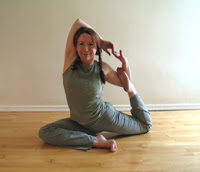by Sandy Blaine
 |
| After the Rain by Joan Webster |
Typically physical exercise is a goal-oriented pursuit; whether the goal is to beat your opponent at tennis, better your time in running, or improve your heart health and increase your muscular strength, you are after results. With yoga, the process, rather than the results, is the point. You will likely improve your strength and flexibility and might even achieve advanced postures along the way, but it is the quality of the experience, and not the outcome, that makes it a yoga practice.
In fact, according to Robert Sapolsky, a Stanford professor and leading stress physiologist, stress reduction activities such as exercise and meditation only work if you enjoy them. So there is little point in forcing yourself through something you don’t enjoy just because it’s good for you; that actually causes more stress and defeats the purpose.
When James Fixx, author of The Complete Book of Running and a leading proponent of the fitness craze in the 1970s died suddenly of a heart attack at age 52, there were a lot of dark jokes, and a lot of second guessing went on. But I wonder, would he really have preferred to have spent his life sitting in a Barcalounger eating chips had he known his fate?
Perhaps that’s the ultimate test: would you regret the time spent if it doesn’t get you the results you’re hoping for? It’s a package deal, the process and the results. That’s another aspect of the yoking together implied by the term yoga. Western culture tends to be highly goal oriented, and it can be hard to wrap our minds around the concept of process. Practicing yoga can yield wonderful rewards, but like everything in life, those rewards are transitory. As blissful as you might feel following your yoga session, there’s no guarantee that you’ll be around to enjoy it again tomorrow. Surrendering the fruits of your labors and being in the moment are tenets of yoga philosophy. And each Savasana is meant to provide a little preparation for ultimately giving up the body altogether.
We can’t know the answer for James Fixx, but when I ask myself that question, I know I wouldn’t regret a moment of my yoga practice. I might increase my ice cream intake if I was given a fatal diagnosis, but I’m positive I’d continue to practice. I might actually devote more time to my practice, in preparation for letting go of life. In the end, it’s not about achieving anything, not doing more advanced positions, nor accumulating more years. Ultimately I’ll die, and I know whenever that is, there will be plenty of feats in Light On Yoga, the bible of asanas, that I never came close to accomplishing. But when I’m practicing, I have moments of being completely present, and aware of being connected to something larger than myself. That’s how I want to live, for as long as I’m alive.

Sandy Blaine has been practicing yoga since 1986, and teaching since 1993. She has a joyful devotion to her daily yoga practice, and seeks to bring these qualities to her classes, which combine her experience and training in the Iyengar, Ashtanga Vinyasa, and Kripalu methods. Her writing has been published in “Yoga Journal,” “Yoga International” and “Ascent” magazines, and she is the author of two books: Yoga for Healthy Knees and Yoga for Computer Users. Sandy is the director of the Alameda Yoga Station and the longtime resident yoga instructor for Pixar Animation Studios, and as a wellness consultant, she has spoken at Kaiser and Google. Previously, she taught yoga at UC Berkeley for many years, and she is a faculty member of the Berkeley Yoga Room’s Advanced Studies Program, from which she graduated in 1995. Find more information about Sandy’s work on her website www.sandyblaine.com. Sandy is at work on a new book about establishing a personal yoga practice, and she blogs about her own practice at www.theyogaguidetohappiness.com.
Follow Yoga for Healthy Aging on Facebook ° To order Yoga for Healthy Aging: A Guide to Lifelong Well-Being, go to Amazon, Shambhala, Indie Bound or your local bookstore.


Leave A Comment